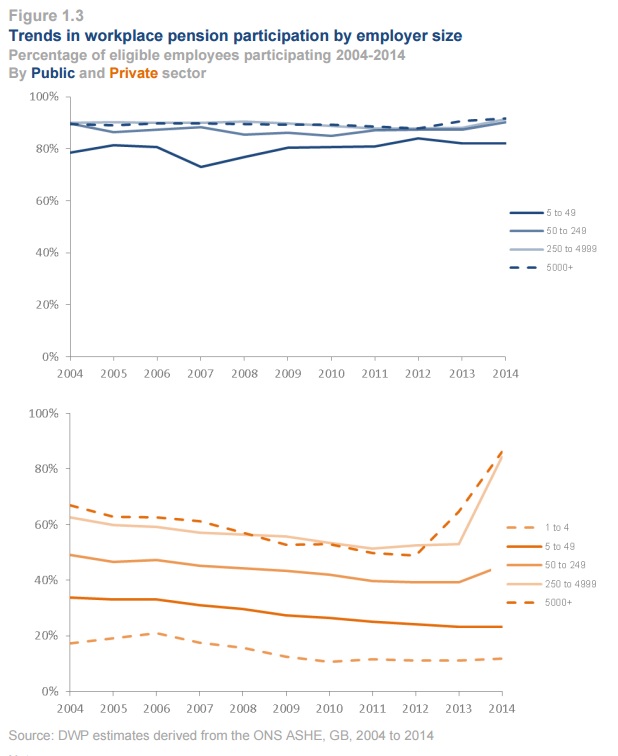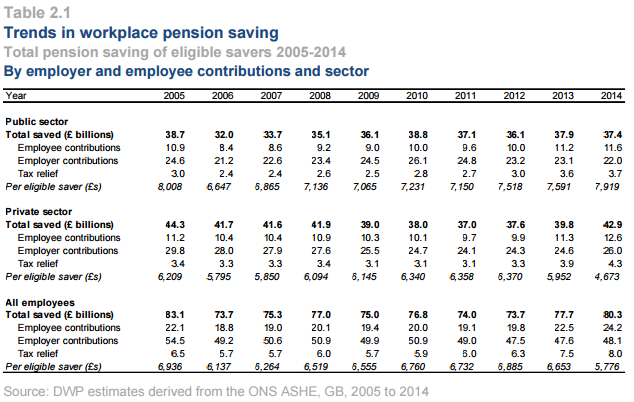From the blog: Participation in UK workplace pensions has risen over the last decade, with auto-enrolment offsetting a downward trend since its introduction in 2012. However, the flood of new members has also served to dilute contributions in private sector schemes.
The DWP report, entitled Workplace pension participation and saving trends of employees eligible for automatic enrolmentis the second in a series of annual updates during the implementation of auto-enrolment.
It looks at changes in saving, both in terms of number of people and the amount of money saved, to measure the success of auto-enrolment against its goals.
The Department for Work and Pensions report, entitled Workplace pension participation and saving trends of employees eligible for automatic enrolmentis the second in a series of annual updates during the implementation of auto-enrolment.
It looks at changes in saving, both in terms of number of people saving and amount of money saved, to measure the success of automatic enrolment against its goals.
Slow decrease, sharp uptick...

The graph shows the overall drop in participation in workplace pensions as a percentage of the population from 2004-2012. In 2004 63 per cent, or 11.9m eligible employees were participating in a workplace pension – this fell to 55 per cent or an eligible population of 10.7m in 2012.
However, it was followed by a sharp rise in participation from 2012 onwards, with 70 per cent or 13.9m participating by 2014.
The graph also shows significantly higher rates of saving among public sector employees, a trend that continues throughout the report.
Tom McPhail, head of pensions research at platform provider Hargreaves Lansdown, said the report illustrated areas where auto-enrolment needed to improve.
"We've still got millions of people who have been through auto-enrolment and still aren't saving into a pension," he said, adding that many failed to meet the minimum income requirements of the policy.
Andy Agathangelou, chair of the Chartered Institute of Payroll Professionals' Friends of Auto-Enrolment, said the pre-2012 decreases could be attributed to low levels of trust in financial services providers.
However, he added the implementation of auto-enrolment offered the opportunity to rebuild trust in the industry.
"Auto-enrolment is all about saying, 'let's do it for [employees]'," he said, adding success was not certain.
"It's not guaranteed the low levels of opt-out won't rise," he said. "No one knows how high they'll become if customers perceive auto-enrolment products to be bad value."
Bigger is better for both employers...

... and pay packets

Perhaps unsurprisingly, the report showed that employees who were part of companies or organisations with more than 5,000 employees or who earned salaries of more than £40,000 a year were the most likely to be saving into a workplace pension.
It noted increases in participation coincided with the staged implementation of auto-enrolment, which started with larger employers.
Despite this, the report stated the largest increase in participation over the period was for those earning between £10,000 and £20,000 annually.
"This is mainly due to a 29 percentage point increase in participation rates between 2012 and 2014, from 21 per cent to 50 per cent," the report said."
Diluted savings

The amount of money saved, both the total and per eligible saver, deceased over the period.
The report noted the total amount of saving between 2013-14 increased to £80.3bn from £77.7bn, but added this was due to the £3.1bn increase in private sector saving, ofsetting the decrease in public sector saving.
"The public sector saw a fall of £0.5bn to £37.4bn [from 2013-14], which is likely to be as a result of a reduction in the number of individuals working in the public sector," the report said.
These saving trends reversed when looking at the amount saved per eligible saver. Mandatory increases in contributions were said to be the cause of a public sector increase to £7,919 per person in 2014 from £7,591 in 2013.
The private sector saw a decrease to £4,673 per person in 2014 from £5,952 the year before.














